
- What is Accounts Receivable Aging?
- Why is Accounts Receivable Aging Important?
- Understanding an Accounts Receivable Aging Report
- How to Calculate Accounts Receivable Aging?
- Best Practices for Managing Accounts Receivable Aging
- Common Challenges in Accounts Receivable Aging & Solutions
- Final Thoughts
- Frequently Asked Questions (FAQs)
What is Accounts Receivable Aging?
Accounts Receivable Aging (AR Aging) is a financial tool used by businesses to track unpaid invoices and determine the creditworthiness of their customers. This report categorizes outstanding invoices based on the length of time they have been due, helping companies assess their cash flow and financial health.
By analyzing an Aging Report, businesses can identify late-paying customers, forecast potential cash flow issues, and take necessary steps to improve collections.
Why is Accounts Receivable Aging Important?
Managing Accounts Receivable effectively is crucial for maintaining a healthy cash flow. Here’s why it matters:
- Improved Cash Flow Management: Aging reports help businesses identify overdue payments and take proactive collection measures.
- Minimized Bad Debt: By tracking late payments, companies can reduce the risk of unpaid invoices turning into bad debts.
- Better Customer Relationships: Identifying late payers allows businesses to communicate with them and offer flexible payment options.
- Stronger Credit Policies: Businesses can assess which customers are reliable and adjust their credit policies accordingly.
Understanding an Accounts Receivable Aging Report
An Accounts Receivable Aging Report categorizes unpaid invoices into different time frames. The most common aging buckets are:
| Aging Period | Invoice Status |
|---|---|
| 0 – 30 days | Current (Not Yet Due) |
| 31 – 60 days | Slightly Overdue |
| 61 – 90 days | Moderately Overdue |
| 91+ days | Seriously Overdue |
Each column in this report represents outstanding balances, making it easier for businesses to prioritize collections.
How to Calculate Accounts Receivable Aging?
The AR Aging process involves three key steps:
- List All Outstanding Invoices – Gather all unpaid invoices, including customer details and due dates.
- Categorize by Due Date – Sort invoices into aging buckets based on their overdue status.
- Analyze and Take Action – Identify overdue invoices and implement collection strategies.
Best Practices for Managing Accounts Receivable Aging
To prevent overdue payments and improve cash flow, businesses should follow these best practices:
1. Establish Clear Payment Terms
- Define payment terms upfront (e.g., Net 30 or Net 60).
- Ensure customers understand due dates before making a purchase.
2. Send Timely Invoices & Payment Reminders
- Automate invoicing systems to ensure invoices are sent on time.
- Send reminders before and after due dates to encourage prompt payments.
3. Offer Multiple Payment Options
- Accept online payments, credit cards, bank transfers, and checks.
- Provide discounts for early payments to incentivize customers.
4. Conduct Regular AR Aging Analysis
- Run aging reports weekly or monthly to monitor overdue invoices.
- Identify problematic customers and adjust credit policies accordingly.
5. Implement a Strong Collections Strategy
- Follow up on overdue invoices with friendly yet firm reminders.
- Escalate severely overdue accounts to debt collection agencies if necessary.
Common Challenges in Accounts Receivable Aging & Solutions
1. High Percentage of Overdue Invoices
Solution: Strengthen credit policies and perform background checks on new customers before offering credit.
2. Poor Communication with Customers
Solution: Maintain open communication, offer flexible payment plans, and provide outstanding customer service.
3. Lack of Automation in Tracking Payments
Solution: Use accounting software like QuickBooks or FreshBooks to automate invoice tracking and payment reminders.
Final Thoughts
Accounts Receivable Aging is an essential financial tool that helps businesses maintain cash flow, reduce bad debt, and improve financial stability. By consistently monitoring overdue invoices and implementing effective collection strategies, companies can ensure steady revenue growth.
Would you like to optimize your Accounts Receivable process? Start today by analyzing your AR Aging Report and taking proactive steps toward financial success.
Have any questions? Drop them in the comments below!
Also Read : What is Accounts Receivable (AR)? Definition, Examples & Best Practices
Frequently Asked Questions (FAQs)
1. What is the main purpose of an Accounts Receivable Aging Report?
The primary purpose of an AR Aging Report is to track overdue invoices and assess a company’s credit risk and cash flow.
2. How often should a business review its Accounts Receivable Aging Report?
Businesses should review their AR Aging Report at least monthly to identify overdue payments and take necessary action.
3. What software can help with Accounts Receivable Aging?
Popular accounting software like QuickBooks, Xero, and FreshBooks can automate AR Aging Reports and payment tracking.
4. What happens if invoices remain unpaid for too long?
Unpaid invoices can lead to bad debt, affecting a company’s profitability. Businesses may need to send overdue accounts to collections.
5. How can businesses encourage faster payments?
Offering discounts for early payments, sending reminders, and providing multiple payment options can help accelerate payments.
Stock Market Crash Today: A Bloodbath on Monday – What You Need to Know
Published on financeslug.xyz The global financial markets are reeling from a massive sell-off, and Indian…
Wall Street Bonuses Reach Record $47.5 Billion in 2024, Up 34% from Previous Year
How to Convert Delimited CSV Data into Columns in Excel
CSV (Comma-Separated Values) files are widely used for data exchange, but when opened in Excel,…
Harvard University Announces Free Tuition for Families Earning $200K or Less
Harvard’s New Tuition-Free Policy: What You Need to Know Harvard University has unveiled a groundbreaking…
Eli Lilly’s 1.8B Dollar Investment in Weight Loss Drugs
Ireland’s Weight-Loss Drug Boom: A Game-Changer for Economy and Healthcare Ireland is witnessing a surge…
Forever 21 Files for Bankruptcy Again: The End of an Era in Fast Fashion?
Forever 21, once a staple in American malls and a leader in the fast-fashion industry,…







